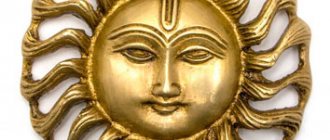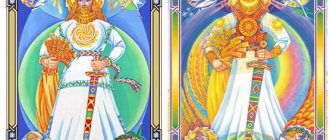Slavic culture identified natural phenomena with a specific deity, where each god was a patron in a certain area or cycle of life. Treating various phenomena and plants of the surrounding world as living entities helped our ancestors live in harmony with nature and themselves.
According to Slavic legends, the sun god had 4 hypostases corresponding to the seasons (life cycle).
- After the winter equinox, the time of Kolyada (personifying a newborn);
- from the spring equinox, Yarilo, a strong, violent young man who loved everything around him, came into force;
- in summer Kupala, the personification of maturity, was honored;
- in the fall, Sventovit took over, meaning the fading sun and depicted as an old man.
Yarilo, the god of the spring sun among the Slavs, was a symbol of love, fertility and awakening.
This article is dedicated to the god of the spring sun - Yarilo.
Yarilo is the god of the Sun. The meaning of the word "Yarilo"
What does the root basis of the name “Yarilo” mean, “yar”, and why did they begin to call the solar god of regenerating nature that way?
The lexeme “yar” is present in many words and toponyms2 formed on its basis. According to the assumption of V.N. Demin in his book “Riddles of the Russian Interfluve”, this is due to the fact that the root “yar” and “ar” represent a single semantic basis emanating from the word “Aryan”. That is, the root “yar” comes from the ancient Vedic “ar”, thus carrying its original essence. Demin gives as an example such names and names as Arjuna,3 Iran (Aryanam),4 Argus,5 Ares,6 Arat7, etc. The relationship of the lexeme “yar” can also be traced with the root “mountains”, about this root basis we discussed in detail in the article about the solar god Khorsa.
The root “yar” is found in words such as “bright”, “yarovoy” (spring), “yara” (an old Russian word meaning spring), “yar” (heat, fire, ardor, heat), “furious” (angry , fierce, hot-tempered, hot-tempered), “fury” (enrage, heat up, irritate), “ardent” (fiery, ardent, strong, lively, sharp, zealous, fast), also “furious” in the meaning of “white, brilliant.” All these words refer to ardent force, a powerful, awakening, fiery, bright, radiant flow of energy. This power is personified by Yarilo, the god of the Sun. As the son of Veles, who is the personification of willpower, the will to life, without which the world would not exist, he awakens nature, endows it with life-giving and fruitful power, with the bright light of the spring Sun shining in the skies.
V. N. Demin in his book “Secrets of the Russian People” also connects the meaning of the root “yar” with time cycles, since from it came the words related to the concept of “season” in ancient Greek and “year” of ancient Iranian and modern German (jahr ), English (year) and Dutch (jaar). After all, it is in the spring, with the revival of nature, that a new life cycle begins - that is, we can say that a new year begins.
God of the ardent Sun of the spring Yarilo Velesich in ancient legends. Image of Yarila the Light
“And hot waves of radiant Yarilin light poured through the Sun...”
“In the Woods” P. I. Melnikov-Pechersky
The mythological tales of antiquity are filled with allegorical descriptions of the confrontation and unity of the forces of nature. The fairy tale of the Russian playwright A. N. Ostrovsky “The Snow Maiden”8 tells how the solar rays of Yarila the Sun brought the death of the Snow Maiden, the daughter of Spring and Frost, who became a victim of the destructive fire of love kindled in her heart with the advent of spring. In his novel “In the Forests,” the writer P. I. Melnikov-Pechersky reproduced the text of the ancient legend about the union of Yarila the Sun and Mother Earth, reflecting the cosmogonic views of our ancestors. Yarilo is described as the god of love and fertility, who illuminated with an ardent light, playing with warm spring rays, Mother Earth, which had been in darkness for a long time. From this union every living thing on earth was born. The eternally young, beautiful-faced, shining god Yarilo illuminated with his gaze the Mother of Cheese, and life-giving power flowed through her veins - the depths, and she was reborn to life, all nature came to life, flowed in stormy streams, adorned the world with lush foliage of a tree, and exuberantly blossomed the world. bestowed So everything that exists awoke to life, including man, who emerged from the depths of Mother Earth, whose mind was enlightened by Father Yarila the bright-faced. But Yarilin’s love did not last long, the time came for him to leave his beloved, and her sadness shed tears with the cold autumn rains. And with the onset of winter cold, Mother Earth fell asleep in anticipation of the return of her beloved, who in the spring awakened her from sleep again with his kiss. And Father Yarilo left a great gift to man, so that during the cold and frost he could warm himself with fire, in which Yarilin’s power was hidden.
In many Slavic legends, Yarila is called Velesich, that is, the son of the god Veles. Veles the wise gave birth to the bright-faced god - Yarila. According to legends and tales, the son of Veles, Yarilo, comes to earth on the first days of spring on a golden-maned horse with a sheaf of rye ears in his left hand and a skull in his right. The zealous horse of the bright god Yarila runs through forests, hills and valleys, 9 and after him all nature comes to life and Mother Cheese Earth awakens from sleep.
In the images, the god of the young Sun Yarilo appears in the form of a young, beautiful-faced, barefoot youth in a white cloak, seated on a white, furious-maned horse, his head crowned with a wreath of fresh flowers, and in his hands he holds a sheaf of ears of grain.
Deities associated with Yarila
The image of the sun god changes with the seasons from the newborn Kolyada to the elderly Svyantovit.
The god of spring and fertility is associated with Yarovit (the Baltic god of fertility). Ruevit is also associated with Yarila, which is translated from the Slavic “r’vati” as breaking the ice sheets.
They also compared it with Kostroma, where, according to some legends, she was Yaril’s wife - Yarilikha. According to other sources, the female hypostasis of the sun god (this assumption is not confirmed).
There was a ritual of honoring Yarila and Yarilikha, which indicates that these are different deities and Kostroma (Kostrobunka) still refers to his wife.
This ritual took place at Kupala, at the end of Rusalya Week (April 15). The role of Yarila and Yarilikha was played by a chosen guy and girl or mummered dolls. They dressed in white elegant clothes and celebrated with games and fun. At the end of the ceremony, the effigy was buried in the ground. The ceremony was dedicated to the main event of the Slavic family - the beginning of the sowing season.
Protective protection of the god Yarilo. Symbol of Yarila
“Yarovik” is the name of the sign of Yarila, which is a symbolic image of the Sun. Yarila's symbol is a four-ray solstice with ends bent in one direction. It is believed that this solar symbol contains within itself the fiery power of God, protecting the owner of the amulet, has a cleansing power that eliminates negative manifestations of energy in his life, gives a surge of strength, and imparts confidence, determination, and courage. Yarovik has four rays, which can mean the four hypostases of the Sun god, in which he appears throughout the year.
Also, a symbol of Yarila can be considered the rune Sovilo (Sol), personifying the Sun, life-affirming energy, sufficient strength to implement good plans into reality, which also means the need to achieve integrity, the opportunity to open up in those areas in which there was no previously realization, and to retreat in a timely manner for restoration of strength in case of loss of energy. Another rune Kenaz (Ken) is also a symbol of Yarila. Symbolically represented as “a torch that disperses darkness,” it means fire, flame, the light of knowledge, illuminating the path of the soul in the darkness of ignorance, which has obscured the world. It symbolizes renewed energy, the revelation of the light of truth within oneself, gives inspiration and drives away fears. Guides you along the path of recognizing true goals in life, without being distracted by temporary, transitory values of the material world and changeable desires.
Amulet of God - Yarovik
Solar symbols and signs were given great attention in the culture of the Slavs. People knew about their effective power and its nature.
They accompanied everyone in their daily routine:
- in ornamental embroidery on clothes;
- in applying marks on dishes;
- in housing;
- on tools.
They were used in the manufacture of amulets and worn as protective protection against negative influences. One of these widely used solar swastika symbols was Yarovik.
What does it look like
It is depicted as a diagonal cross with crescent-shaped curls at the ends. In this way it symbolizes the annual, seasonal movement of the sun, in which each of the four periods was subordinated to one of the four solar gods. The sign conveys the purity and accuracy of the movement of the luminary; its power triggers certain earthly processes at their appointed time.
Who is it suitable for?
Since Yaro-god touches the entire earth’s surface with his sunlight, and there is no place on it that he would not mark with his radiant gaze, an amulet or clothing using this sign of Yarilin’s all-pervading power should be worn by people prone to melancholy and despondency, obsessed with melancholy . Through this, all the darkened corners of their soul will be illuminated, for this sign has the ability to give light to those who have lost it.
In addition, spring grass is suitable:
- for boys - to gain strength, courage, cheerfulness and curiosity;
- for young men - to cultivate masculinity, strengthen the joy of every day, and meet their betrothed;
- for a man - to feel the fullness of life and daily joy, to convey positive experience;
- for girls - to meet their betrothed, to develop feminine qualities;
- for married women - to maintain and increase passion in marital relationships, to give birth to strong and strong children.
The power of the amulet
This symbol brings awakening of vitality where it is used. It is also used to preserve and increase material wealth. It was not for nothing that it was applied to windows and shutters, ceilings and roof slopes, gates and barns.
The protective, cleansing and all-pervading power of the sign was used to protect livestock and increase its population. For this reason, it was applied above the entrance to stables and cowsheds, sheepfolds and barns to protect their property from the forces of the elements, wild animals and thieves.
Holidays dedicated to the golden-faced god Yarila
“Yarilo is the ancient Slavic god of fertility, from whom the earth and all living things rage.”
“Explanatory Dictionary of the Living Great Russian Language” by V. Dahl
There are several days a year when the god Yarila and his power, the revitalizing nature, are revered.
One of the holy days when the power of Yarilin is revered is May 22, which is called “Yarilin’s Day.” According to some legends, the god Yarila was born on this day from Veles the Wise. The holiday dedicated to Yarila is the day of the beginning of spring - March 9, when from the tops of the hills they call for spring, inviting them to come, melt the snow and bestow warmth and light on the earth.
The day of the vernal equinox, March 20–21, is dedicated to the god Yarila. From this moment, the light time of the day begins to prevail over the dark, the day lengthens more and more, and the night shortens - so the light Yarilo drives away the darkness with his rays from the earth, warming it and awakening it from sleep. On the days of March 24–25, the strength of Yarilin is also revered, celebrating the arrival of spring. When Maslenitsa comes, pancakes are traditionally baked - a symbol of Yarila the Sun.
The holiday of Yarilo, referred to as “Yarilo the Spring”, also falls in the spring - April 23, when Yarilo, with fresh dew, endowed with healing powers, sends the grass into vigorous growth. Yarila’s summer holiday is called “Yarilo Wet” and falls on June 3, the day when spring is replaced by red summer. Also, dew is considered today to have healing properties and extraordinary powers endowed by the god Yarila himself.
On the day of the summer solstice on Kupala, a ritual of farewell to Yarila is carried out, burning a straw doll made of branches and twigs depicting the solar god on a fire with crying and laughter, scattering the ashes in the field so that the Ardent Solar God will appear again in the spring and revive Mother Nature. However, there is an opinion that the day of the summer solstice is also called Yarilin. According to the version of S.V. Zharnikova, Yarilin’s day falls on June 20–21, the beginning of the “Night of the Gods,” when the Sun turns on its way to the south, towards winter, and the daylight hours begin to shorten. A. S. Famintsyn in his book “Paganism as It Is” (1897) says that the day of the summer solstice is called “Kupala”, but in some places this holiday is called “Yarilo”.
Another summer day, July 24, is a midsummer holiday dedicated to the Sun-Yaril and Perun the Thunderer.
Myths about Yaril
Yarilo is the embodiment of youth and life, so in myths he often plays the role of a lover. Moreover, according to some signs, it becomes clear that God is in love with all women on earth and even the Earth itself.
The main myth about Yaril is the story of the creation of life. There is such a variant. For a long time, Mother Earth slept soundly, but somehow Yarilo appeared and began to wake her up with his caresses and passionate kisses. The kisses were as hot as sunlight, and the Earth, warmed by them, awakened. And in the place of the kisses, fields, forests, and meadows appeared. The sun god continued to kiss the Earth. And lakes, rivers, seas, oceans appeared on it. The earth became hot from Yarila’s caresses and gave birth to insects, fish, birds and animals. Man was the last to be born.
This is one of the versions of the pagan myth about the creation of the world and the emergence of life.
We meet Yarilo - the clear sun on the vernal equinox
“What Kupala, what Yarilo - everything is one, one God’s title.”10
As you know, there are four sacred days in the year on which the ardent power of the bright-faced Sun is revered: be it Kolyada (winter solstice day), Kupalo (summer solstice day), Khors (autumn equinox day) and Yarilo (spring equinox day). So, the Sun seems to be one, but our ancestors revered it in different faces and under different names, for it appeared in four forms at different times of the year: in winter, like the baby Kolyada, the winter Sun, illuminating the earth with a renewal, on the day of the winter solstice turning from winter to summer; in the spring he appears as the young man Yarilo, the ardent spring Sun, who from the day of the vernal equinox assumes his rights as the dominant Solar God in the heavens; on the day of the summer solstice, the mature Kupala appeared to replace him, and from that day on the path of the Sun turned from summer to winter; and from the day of the autumn equinox, old Horse shone in the sky, completing the cycle of the annual path of the Sun.
Thus, symbolically, we are presented with a picture of the cyclical existence of all things. From birth to death, everything manifested in our Universe passes its path, be it a person, a planet or a galaxy - the path of all living things passes through birth and dying, which in turn opens the gate to a new birth.
On the day of the arrival of spring, and with it the ardent forces of the golden-rayed Sun, Yarilo rises on his furious-maned horse in the heavens, disperses the dark winter clouds, and brings light and warmth to Mother Earth with fertilizing winds blowing across the earth, filling with fertile forces and leading to flowering ardent forces of nature awakening. This is how Stry-Stribog helps Yarila to revive nature to life.
The day of the vernal equinox, which falls on March 20 or 21, is marked by the fact that in the Northern Hemisphere winter ends and warm seasons come to replace it, while at the same time in the Southern Hemisphere the autumn equinox comes and cold weather comes. On the day of the vernal equinox (as well as on the day of the autumnal equinox), the day is approximately equal in length to the night. This occurs due to the Sun crossing the celestial equator in its apparent movement across the sky.
The spring equinox has a rich history of celebration in different countries of the world, going back centuries.
On this day, interesting events occur related to the passage of the Sun along the celestial equator. So, in Cambodia, the Sun rises exactly above the main tower of the Angkor Wat temple complex, dedicated to the god Vishnu. The Ancient Egyptian Sphinx is installed in such a way that it looks directly at the sunrise on the day of the vernal equinox. At Chichen Itza (Mexico), the Sun creates the illusion of a snake moving along the northern staircase of the pyramid.
The celebration of the vernal equinox coincides with such holidays as Nowruz (translated as “new day”) - the Persian New Year, celebrated in some eastern countries, such as Azerbaijan, India, Kazakhstan, China, Mongolia, Pakistan, Uzbekistan and others, and also in Europe and Russia: in Albania, Georgia, Bosnia and Herzegovina, Bashkortostan, Dagestan, Tatarstan, etc. In some countries, the New Year is celebrated on the day of the vernal equinox (Afghanistan, Iran, Tajikistan). This day is also the first day of the Iranian calendar. Holi, an Indian flower festival, falls on the days leading up to the spring equinox. In Japan, the seven-day holiday Shunbun-no-hi is associated with the spring equinox - a day of glorifying the forces of nature and showing love for all living beings.
Deity symbols
Each deity in the Slavic pantheon has its own symbols, which were used to create amulets and amulets. With their help, people could find favor and receive the gifts of the famous gods.
Kolovrat
It is one of the most famous Slavic solar swastika symbols. Proper handling of it provides the wearer with protection from troubles and misfortunes.
It has nothing to do with the fascist swastika, although it is often confused with it. This symbol contains the secret of the celestial movement of the sun. It looks like a fiery wheel with rotating spokes and contains the image of the eternal rotation of the main heavenly body, as well as the rotation of the wheel of life, which the gods give and take away.
It is also a symbol of the following concepts:
- the immensity and incomprehensible infinity of the Universe, its eternal rotation;
- personification of the eternal victory of life over death, order over chaos;
- reminders of the Sun and Light;
- changes in cosmic epochs, annual cycles, day and night.
Salting and Anti-salting
It is believed that a symbol with right rotation, called Posolon (according to the Sun), the rays of which are directed along the movement of the Sun, i.e. clockwise, means the revival of life in the period from the end of December to the end of June (solstices). It also meant abundance, pure thoughts, protection from natural forces, good deeds and regularity.
The symbol with left-hand rotation, called Antisolon (against the Sun), means the movement of the luminary in decline, towards sleep (the movement of the rays counterclockwise). Describes the period from the end of June to the beginning of Kolyada (the day of the winter solstice).
This symbol means:
- life after death and the other world;
- supernatural skills;
- developed intuitive abilities;
- conscious interaction with the subtle plane.
At that distant time, this sign could be worn by a woman called the knowing mother, who later began to be called a witch, giving this word a negative connotation for ideological reasons.
It was believed that such a woman with mystical abilities, wearing this sign, could protect her entire family from negative influences.
Kolovrat come with four, six and eight rays. With four - symbolizes the element of fire, with six - connection with Perun and with eight - means the unity of everything that exists.
Colard
This sign is a sacred symbol, personifying a single universal fiery energy, thanks to which great and small cycles of renewal and transformation occur.
Symbolizes purification through the unification of two genera by the union of loving hearts. It was applied to the ornamental embroidery of the newlyweds’ clothes so that the energetic, spatial structures of the sign, taking the most worthy of the image of the spirit and blood of the coupled young people, could influence the genetics of the unborn child, combining in him all the best from the father and mother.
This symbol also carried the deep sacred meaning of the sacrament, which, through the purification of the spouses, will give them great wisdom and convey the spiritual experience of their ancestors.
England and the Star of England
Inglia symbolizes the fire of divine creativity, from which the worlds and gods were created. In the very heart of Yarila, England burns with an unquenchable eternal fire, pouring out onto the earth, defeating darkness and giving light. This is a symbol of the original divine purity, protecting the world from chaos and darkness.
This swastika symbol in terms of geometry differs from the Star of England, which is a nine-rayed star, which is formed by three equilateral triangles, denoting the triplicity of the structure of earthly and cosmic phenomena.
For example:
- Body, soul, spirit.
- God the Father, God the Son, God the Holy Spirit.
- Worlds: Reveal, Navi, Rule.
Nine rays - the number of the gods of the Slavic Nine Heads: Svarog, Khors, Perun, Stribog, Orey, Indra, Varuna, Mertsana and Yarilo.
This symbol can enhance the protective power of any sign; to do this, it must be inserted into the center of the star. The star itself is enclosed in a circle to accumulate the energy of the symbols.
Svaor-solntsevrat
This sign is a symbol that describes the movement of the human soul, just as the eternally young solar god on his horse moves across the sky from dawn to dusk. Likewise, a person, in the process of his spiritual growth, rises from rejection, reproaches, doubts and discontent to purity of thoughts and spiritual perfection.
This amulet is an assistant in choosing your life path and in resolving difficult life situations and eliminating problems.
From this video you can learn about another symbol of the Yaro-god.
We welcome the light of Yarila on the day of the spring equinox - a holiday of the rebirth of nature
On this day it is especially important to come to a state of balance and harmony. Meditation practices that balance consciousness in the moment here and now will help you with this. This is a state of accepting everything that surrounds us as it is. It is the attunement with the space outside that creates balance and harmony within.
On the night before the spring equinox, it was customary to light bonfires to help the light overcome the forces of darkness. If you are in the city, light a candle at home, calling on the bright radiance of Yarilin’s fire. On this day, try not to give in to emotions and heavy thoughts.
Conduct a meditation to discover the source of happiness in yourself. Take a comfortable position, close your eyes, relax and imagine that you are filled with a feeling of complete absolute happiness. Feel how this power of bright joy fills you, and try to determine for yourself what you need to achieve such a state in life - perhaps it will be the absence of fear, pain, attachments, or a feeling of independence and freedom. You will be able to accurately identify what is hindering your happiness. Most often, these are limitations caused by false self-identification. After you complete the meditation, you will come to the realization that without trust in life, love and acceptance, true happiness is impossible. The temporary substitutes for happiness that we deceive in our lives only create a feeling of joy for a short time. However, what we lack to get out of the cycle of suffering is found within ourselves. Nothing external can replace the light of pure joy that comes from within.
Yarlo - heart center, center of the soul
The controlling force of the heart energy center is Yarilo and is called “Yarlo”. In one version, the energy vortex of power in the area of the heart is called “Percy”; through it, the life force of Yarila the Sun is absorbed and creative energy is emitted. In trusting life, a person, opening his heart to the world, straightening his shoulders, opens his soul. Any non-acceptance, self-restraint, self-flagellation, self-abasement from the physiological side is manifested by tightness precisely in the area of the thoracic spine, which results in stooping and hunching as a consequence. A person who has blocked the natural flow of life force is immediately visible by these signs.
Rejection and suppression are two actions that block life force. Suppressing your emotions also leads to the formation of energy blocks and clamps. Expression of emotions should not go to extremes. Both excessive indulgence and suppression of emotions are a violation of the state of harmony and balance. We shouldn’t let the mind play a cruel joke on us - on the path of spiritual development, many fall into the trap of thinking that by controlling emotions it is the suppression of them, but we are talking about the golden mean, beyond extremes.
There is no need to look for flaws in yourself. We are all unique and will always be somewhat different from each other, no one is perfect in this world. Ideality is a lack of vitality and a blockage of the natural flow of life force. Blind adherence to the generally accepted standard of any “ideal” leads to enslavement in the heart energy center of Yarlo. There is no need to strive for “ideals” - this is just one of the fictions of the mind that limits our consciousness. Allow yourself to live as your soul asks, at the call of your heart!
Yarilin's power. Energy of Ra
The powerful energy of light Ra is the force that the god Yarilo also personifies. How a person manages this energy depends on his internal potential and level of spiritual development. He can release energy to satisfy his insatiable desires, he can generate this divine power for the benefit of all things. This is a force that gives life and at the same time destroys and destroys. Playing with this energy is unacceptable - no practice will help raise or accumulate the energy of Ra, since it comes into motion only thanks to the natural flow of vital force. This stream of power combines two energies of existence: the stream of Yarila, descending from heaven, which is a creative creative force, fiery, filling - this is the essence of male power, radiating; and the stream of Zhiva, rising from the earth, is a receiving force, transforming fiery force into the energy of life, giving life, feminine energy, reflecting. These two streams are present in every person. Their essence is the same - when united, they create harmony and balance. Both of these flows must be balanced, uniting at the heart energy center. After all, this is where the center of vitality is located, radiating love and bright joy.
Yarilo - god of love
“Love moves the Sun and luminaries”
Dante Alighieri
Yarilo, with the arrival of spring, awakens nature with the power of love and creative creation. Love is the basis of the universe. Thanks to the supreme power of love, the whole world was created. A person is happy when he is in an atmosphere of love, because where there is true love, there is no place for fear and pain. The life-giving power of love permeates everything in this world.
Only someone who is full of love can give love, and the world will respond in kind - such a person will be loved. As you know, the main desire in all of Creation is the desire to live and the will to live, without which the entire universe would not exist. Therefore, any violence, including demands, restrictions, actions committed against the will, generate a blockage of the flow of energy and vitality.
When a person limits himself, considers himself unworthy of happiness, then life will limit him, narrow his freedom and not give him what he wants. After all, he himself blocks this flow. Self-restraint and self-denial, contrary to many spiritual concepts, lead to a person suppressing his nature through self-rejection. After all, the way we treat ourselves is projected onto us by the world. Self-dislike and lack of self-confidence lead to the fact that others do not love or respect us. As a rule, people respect someone who accepts himself as he is; the whole world will accept such a person.
Since childhood, the need to meet the requirements of someone hangs over us with a heavy burden. Be it parents, educators, teachers, then bosses, etc., this gives rise to a person’s dependence on other people’s opinions, uncertainty and demands on himself, which leads to self-acceptance, denial and struggle with himself.
However, until we see God in ourselves and in all things, we will not be able to love ourselves and the world around us. Everyone knows the word “idolize”; in essence it means “to create God.” Idolize yourself, then you will not demand veneration, respect, attention from other people, for you will reveal this source in yourself.
If we do not accept ourselves, then we are opposed to the divine plan and nature, because we are in a state of rejection and denial, struggle and opposition to this world. There are neither good nor bad in the world. Each soul is unique, has its own unique experience of all incarnations and represents a piece of God. Therefore, by rejecting and denying something in ourselves, we deny God.
To love yourself means to love God in yourself. Accepting yourself means recognizing yourself as an integral part of divine existence.
How to properly clean and charge?
With constant use, the amulet absorbs a lot of negative energy emanating from surrounding people. And it is necessary to clean your talisman and recharge it from time to time so that it can continue to serve its owner. These actions must be carried out by the owner of the talisman himself.
We recommend: Ancient Slavic amulets for men: what are they and how to wear them?
All cleaning methods are closely related to the influence of natural forces, the cycle of energy, the ability of our mother nature to absorb unclean matter.
Four elements can cleanse the amulet:
- Water - it should be running, preferably, of course, spring water or spring water, river water, but tap water is also suitable, as long as it does not stagnate. Can be washed with melt or rain water.
- Fire can be the flame of a fire, a candle, and after the ritual the candle is immediately thrown into an inaccessible place so that no one else can use it. The amulet is carried several times over an open flame; it is believed that all unclean energy is burned in the fire.
- Earth - to carry out the ritual, you need to bury the talisman shallowly in dry, loose soil overnight; it will be more effective to fence this place with natural stones.
- Air - the method involves fumigating the amulet with the smoke of magical herbs; it is good to use incense from cedar or sage. The advantage of this method is that the room in which the action is performed is also cleaned.
If you suspect that your amulet has been subjected to a strong negative impact, then you can put it in salt for three days. This mineral is capable of absorbing negativity very well. After this, the salt must be thrown away, buried or washed off with water.
Fresh air and sun rays will help recharge your talisman. It is best to place it outside, in a ventilated place, directly under the open sun, but in a quiet place where the ritual will not be disturbed by prying eyes.
Yarilo - god of joy
In one of his incarnations, Yarilo appears as a god who brings bright joy. Joy is a phenomenon in life when a person has enough bright light in his heart and vitality. Therefore, this is how the word “joy” can be interpreted - the light of Ra in abundance is the same bright energy of Ra, the personification of which is the god Yarilo. Everything we do in life should be a joy for us when there is no imbalance between external and internal. It happens that the Soul asks for one thing, but the mind persistently assures us that we need something else. As a rule, in our pragmatic times, many are unable to accept what the soul needs, and they follow the demands of the mind - this inevitably leads to a loss of harmony. If we “give in” to the persuasion of the mind, then at such moments we lose connection with God. Karma is an action committed against one’s nature, one’s being, in a state of loss of harmony. And this action will certainly be compensated according to the law of balance, on the basis of which our entire world exists. What we emit into the world is reflected back to us. By doing something against our will, we lose the vital fiery force that supports life in us, which is a manifestation of divine energy, revealed by God Yarila in this hypostasis.
PS Yarilo shows us the path to our nature, source, revealing ourselves and our hearts to the world, so that we can freely express ourselves and live in such a way that our hearts are joyful and our souls happy, without resisting the flow of life in ourselves and without blocking this energy. Learn to evaluate and recognize all your actions according to your heart, not contrary to your nature and your nature - this is the lesson Yarilo gives us. Not every person can afford to live in joy and be happy, because he has made his happiness dependent on the outside world, but not on himself. Although the source of happiness is in ourselves, and what our lives will be filled with depends only on us. In order to become happy, we need our own permission to do so. The light that illuminates our path comes from within. We are the masters of our own destiny. We just need the courage to trust life and follow where our energy flows, without blocking our path or creating obstacles to the flow of life in us.
Glory to Yarila! Glory to our Gods and Ancestors! Ohm











